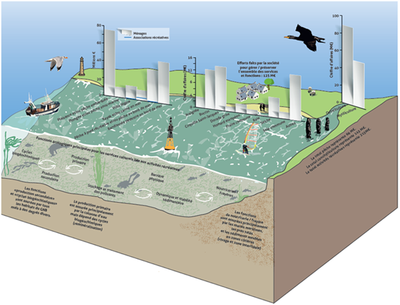3.5.7 Ecosystem accounting

In 2012, a satellite account called the “System of environmental-economic accounting Central Framework” [SEEA, 2013] was published by the United-Nations in order to incorporate the envi-ronmental assets in the national accounts and to estimate the defensive expenditures.
The conventional accounting indicators are adjusted in order to take into account the depletion of natural resources and produce an adjusted Gross Domestic Product (GDP), also called “green GDP”.
However, the SEEA focuses on natural resources, considered as well identified and separated economic goods. An experiment was carried out by the United-Nations to extend the SEEA to ecosystems: The SEEA Experimental Ecosystem Accounting [SEEA-EEA, 2013]. The SEEA-EEA focuses on asset accountings; therefore, one of the major challenges of the SEEA EEA remains to define monetary valuation methods to provide a monetary value of ecosystem services which would be consistent with the accounting approach. Indeed, the Ecosystem Services Approach has not solved all the methodological problems raised by the monetary valuation of natural capital.
For this reason, a complementary approach was adopted within the VALMER project: we developed an ecosystem satellite account, which encompasses the activities using or maintaining the ecosystem services and estimates all the resources and expenditures of these activities. For the second type of activities, it can be referred to one existing functional account of the SEEA-CF, which values the different means implemented by a society in order to avoid environmental degradation or to maintain or to increase the production of ecosystem services. Ideally, this satellite account of activities using or maintaining ecosystem services should be complemented by a physical account which would provide indicators of the ecological input used by these activities or the ecological outputs they may produce. Contrary to the SEEA-EEA, the environmental degradation would not be valued in monetary units, but in physical units. This approach was applied to the Golfe Normand-Breton study site.
 Figure: Ecosystem satellite accounting: incorporating ES in the SEEA-Central Framework
Figure: Ecosystem satellite accounting: incorporating ES in the SEEA-Central Framework
An important issue for the integration of ecosystems in the SEEA is the assessment of ecosystem cultural services. Most of those services are obtained through a process of “production for own use” by the households. It is thus necessary to extend the production boundary of the System of National Account in order to integrate those activities.
 [ Find out more about the ecosystem accounting in the Golfe Normand-Breton case study ]
[ Find out more about the ecosystem accounting in the Golfe Normand-Breton case study ]

